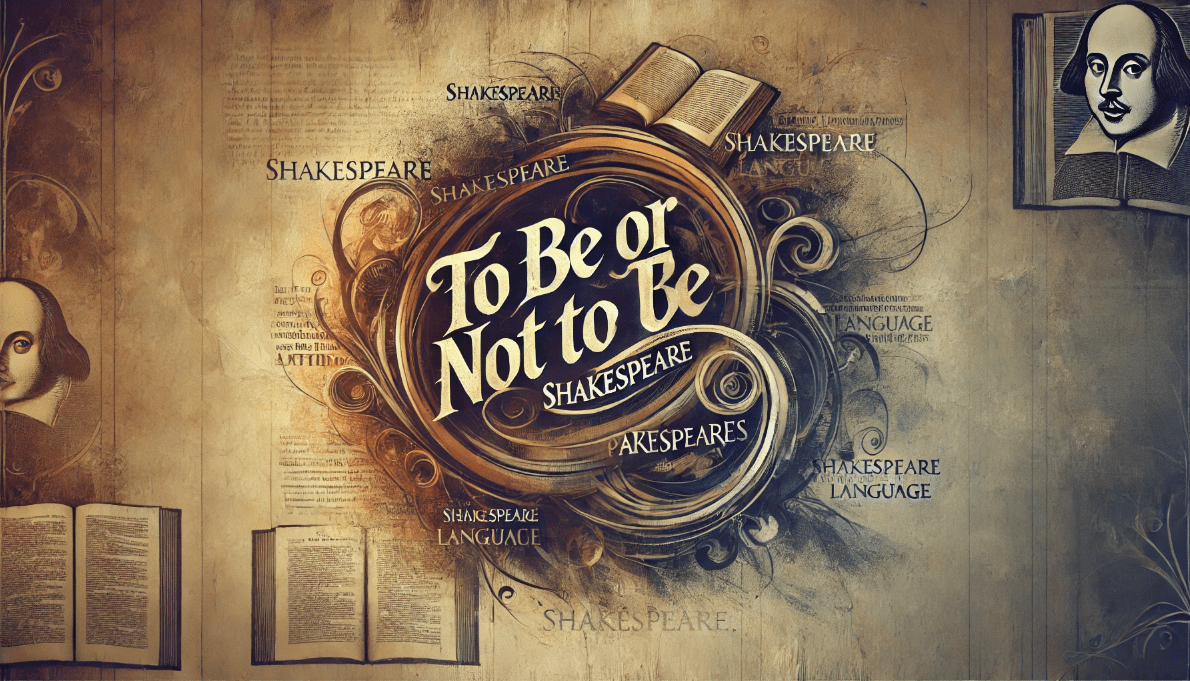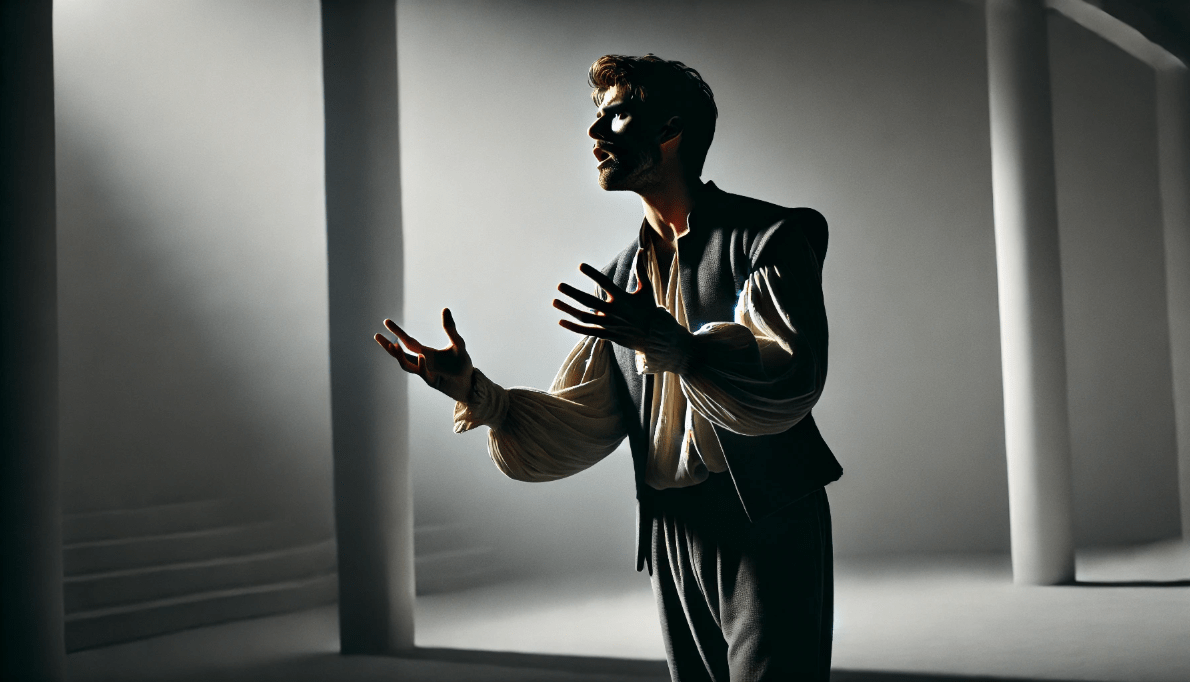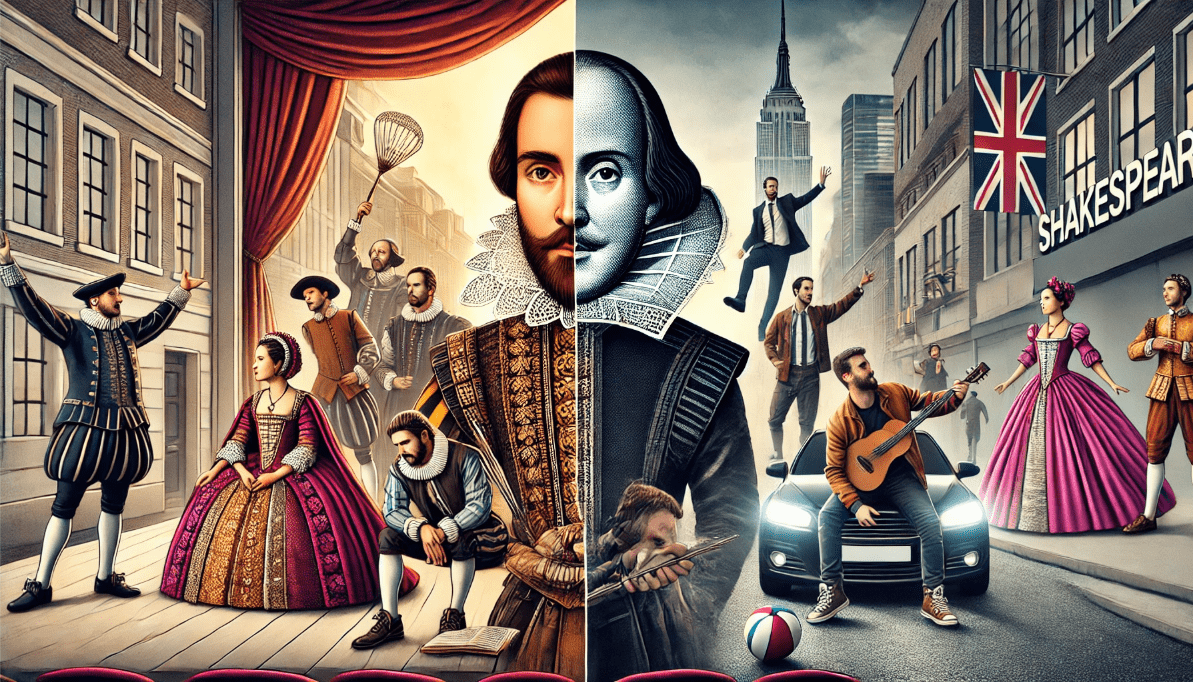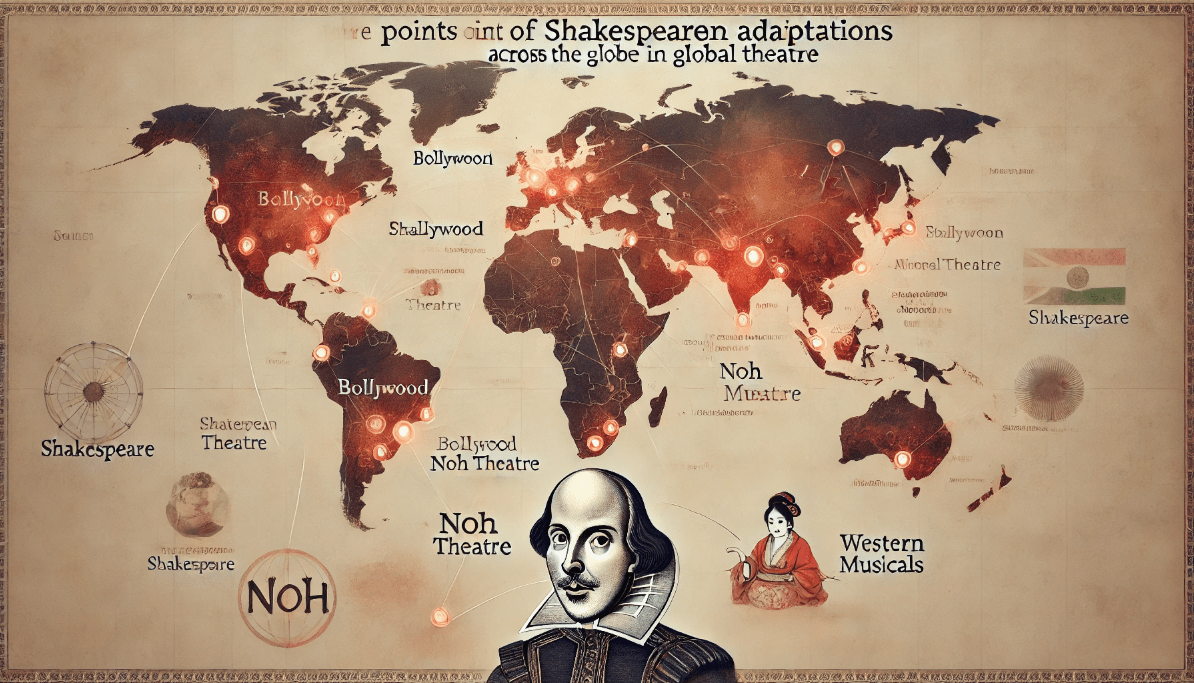
Shakespeare’s Contribution to the Theatrical Canon: How His Works Shaped Modern Drama and Performance
William Shakespeare, often hailed as the greatest playwright in history, left an indelible mark on the world of theatre. But how exactly did Shakespeare’s contribution to the theatrical canon shape the drama and performances we see today? 🤔
From complex characters to innovative language and revolutionary storytelling techniques, Shakespeare transformed the stage in ways that continue to resonate in modern plays, films, and performances. Whether you’re a budding playwright, actor, or just a curious theatre enthusiast, understanding these lasting influences can deepen your appreciation of both classical and contemporary works.
In this article, we’ll explore how Shakespeare’s timeless creations not only defined the theatre of his time but also set the stage for modern drama. By the end, you’ll have a clearer understanding of why his works still captivate audiences—and how they shape the plays you see today. Let’s dive in! 👇
Table of Contents
Toggle1: Who Was Shakespeare and Why Is He Still Relevant Today? 🎭
Who Was William Shakespeare?
William Shakespeare, born in 1564 in Stratford-upon-Avon, is widely considered the greatest writer in the English language. Over his career, he penned 39 plays, 154 sonnets, and a variety of poems. His works have transcended time, language, and culture, becoming essential to the global theatrical canon.
Shakespeare was not just a playwright; he was a poet, actor, and an astute observer of human nature. His ability to create compelling stories and characters has made his work enduringly popular, from stage performances to film adaptations. But why is he still relevant in modern theatre?
Why Shakespeare’s Works Are Timeless 🌍
- Universal Themes:
Shakespeare’s plays explore the complexity of human emotion, from love and jealousy to ambition and betrayal. These themes are timeless because they resonate with every generation. Whether it’s the tragic downfall of Hamlet or the passionate romance in Romeo and Juliet, his stories touch on core human experiences that still matter today. - Rich Characterization:
Shakespeare’s characters are multi-dimensional. Take Hamlet, for instance—he’s not just a prince seeking revenge; he’s a deeply conflicted individual grappling with existential questions. This level of complexity was groundbreaking for his time and continues to inspire writers and actors who strive for similarly rich, nuanced characters in modern works. - Influence on Language:
Did you know that Shakespeare introduced over 1,700 words to the English language? He coined phrases like “break the ice” and “wild-goose chase,” which are still used in everyday conversation. His inventive use of language revolutionized English and continues to influence writers, poets, and playwrights.
Why Does Shakespeare Matter Today? 🤔
Shakespeare’s works remain relevant not only because of their literary brilliance but also due to their adaptability. Directors and playwrights continue to reinterpret his works for modern audiences, from futuristic retellings to unique cultural adaptations. West Side Story reimagines Romeo and Juliet in 1950s New York, while The Lion King draws inspiration from Hamlet. These adaptations prove that Shakespeare’s core themes—love, power, identity, and fate—are just as important today as they were in the Elizabethan era.
Moreover, Shakespeare’s plays continue to serve as foundational texts for theatre training. Modern actors and directors still study his works to learn about dramatic structure, character development, and performance techniques. His influence on acting styles, particularly classical training, remains a cornerstone of theatre education worldwide.
2: Shakespeare’s Major Contributions to the Theatrical Canon 🎭
Shakespeare didn’t just write plays—he revolutionized the way we understand drama and performance. His innovations shaped not only the theatre of his time but also the theatre we enjoy today. Let’s explore some of his most important contributions that still influence modern drama.
The Creation of Complex Characters 👥
One of Shakespeare’s greatest achievements was his ability to create deeply complex, multi-dimensional characters. Before him, many characters in plays were often one-dimensional, representing clear-cut virtues or vices. Shakespeare broke this mold by giving his characters depth, inner conflict, and real human complexity.
- Example: Hamlet, the conflicted Danish prince, isn’t just seeking revenge—he’s questioning life itself. This kind of psychological complexity was revolutionary.
- Impact Today: Modern plays and films still feature characters grappling with complex emotions, motives, and moral dilemmas. Shakespeare set the standard for multi-dimensional character development.
Exploring Human Psychology Through Drama 🧠
Shakespeare was ahead of his time in exploring the psychological depth of his characters. His understanding of the human mind allowed him to depict not just actions but also the motivations, fears, and desires behind them.
- Example: In Macbeth, the psychological effects of guilt and ambition are explored in depth as Macbeth and Lady Macbeth spiral into madness.
- Impact Today: Contemporary plays, films, and TV shows often focus on character psychology, showing how mental and emotional struggles shape individuals’ decisions and actions.
Blending Genres and Play Structures 🔄
Before Shakespeare, plays were often confined to strict categories: tragedy, comedy, or history. Shakespeare blurred these lines by mixing genres, creating works that were dynamic and unpredictable. His mastery of structure allowed him to switch tones—combining comedy and tragedy in a single play, making them more engaging and complex.
- Example: The Winter’s Tale is a perfect mix of tragedy, comedy, and romance, surprising audiences with its tonal shifts.
- Impact Today: Modern playwrights and filmmakers use this approach to create richer, more layered stories that feel both emotionally powerful and surprising. Think about films like The Dark Knight, which blends action, drama, and psychological thriller elements.
The Use of Soliloquies and Monologues 🎤
Shakespeare introduced soliloquies—monologues delivered by characters while alone on stage—as a way to let the audience in on the character’s inner thoughts. These speeches provide insight into a character’s mind, allowing the audience to connect on a deeper level.
- Example: Hamlet’s “To be or not to be” soliloquy is the epitome of exploring existential questions, making it one of the most famous passages in all of literature.
- Impact Today: Soliloquies are still used in theatre and film to express a character’s personal dilemmas and inner conflicts. Modern actors and playwrights continue to draw from this technique to engage their audiences emotionally.
Mastering Dialogue and Language 🗣️
Shakespeare was a genius with language. He had an unparalleled ability to play with words, using puns, metaphors, and vivid imagery. His poetic dialogue often made the ordinary feel extraordinary, and his ability to convey complex ideas through seemingly simple phrases is unmatched.
- Example: In Romeo and Juliet, Shakespeare’s use of metaphors to describe love—such as comparing it to a “star-crossed” destiny—elevates the entire narrative.
- Impact Today: His mastery of language influences how dialogue is written in modern plays and movies, from poetic monologues to sharp, witty exchanges.
3: The Language of Shakespeare and Its Lasting Influence ✨
Shakespeare was more than just a master of drama; he was a linguistic innovator who transformed the English language. His creative use of words, phrases, and expressions has left a lasting impact on both theatre and everyday speech. Let’s explore how Shakespeare’s language shaped modern drama and why it continues to influence writers and performers today.

The Power of Words: Shakespeare’s Inventive Language 📝
One of Shakespeare’s most significant contributions to the theatrical canon is his profound influence on the English language. He didn’t just write; he reinvented how we speak. Shakespeare coined over 1,700 words and introduced countless new expressions, some of which are still in common use today.
- Examples: Words like “eyeball,” “swagger,” and “lonely” were all introduced by Shakespeare. He also gave us phrases like “break the ice,” “wild-goose chase,” and “heart of gold,” which are still widely used.
- Impact Today: His playful manipulation of language encourages modern playwrights, poets, and even advertisers to explore language creatively. Shakespeare’s impact on language is part of why his work feels timeless and adaptable.
The Art of Wordplay: Puns, Metaphors, and Double Meanings 🎭
Shakespeare had an extraordinary ability to use wordplay to add layers of meaning to his work. His writing is rich with puns, metaphors, and double entendres, which both entertained audiences and made his characters’ dialogue sparkle with wit and depth.
- Example: In Twelfth Night, the character Feste uses puns to comment on the absurdity of life, creating both humor and deeper reflections on human nature. His dialogue is filled with double meanings, making each line not just funny but also thought-provoking.
- Impact Today: Modern plays and films often rely on witty dialogue, as Shakespeare’s clever use of wordplay set a standard for integrating humor and deeper meaning. Whether in theatre or film, wordplay continues to be a powerful tool for writers and performers.
Vivid Imagery and Emotional Resonance 🎨
Shakespeare was a master of vivid imagery—using striking visual language to evoke emotions and create powerful, memorable scenes. His ability to paint pictures with words is one of the reasons his works remain so captivating. The imagery he used often served as a way to express complex emotions, setting the tone for the entire play.
- Example: In Macbeth, Shakespeare describes the blood-stained dagger as a symbol of guilt, creating an image that lingers in the audience’s mind. Similarly, his references to nature in King Lear reflect the storm raging inside the characters’ hearts.
- Impact Today: Modern theatre, film, and literature still rely heavily on imagery to evoke emotion. Shakespeare’s ability to connect the physical with the psychological inspired generations of writers to create powerful visuals that resonate deeply with audiences.
The Universal Appeal of Shakespeare’s Language 🌍
One of the reasons Shakespeare’s language is so enduring is its universal appeal. Despite being written over 400 years ago, his works are still relevant and accessible. His themes, such as love, power, jealousy, and betrayal, speak to the universal human experience, making his language not just important for historical reasons but for its ability to communicate across time and cultures.
- Example: Romeo and Juliet’s exploration of young love and fate continues to resonate with audiences worldwide, even when adapted into different languages and cultures.
- Impact Today: Many modern adaptations of Shakespeare’s works translate his language into contemporary settings, but the core of his poetic and emotional power remains intact. Filmmakers, playwrights, and poets often revisit his works for inspiration, adapting his timeless language to new contexts.
Shakespeare’s Influence on Modern Playwriting ✍️
Shakespeare’s language isn’t just something to admire from a distance—it’s also something modern playwrights actively draw upon. His ability to combine emotional depth, wit, and intellectual complexity in his language is something contemporary writers strive to emulate.
- Example: Playwrights like Tony Kushner (Angels in America) and Tom Stoppard (Rosencrantz and Guildenstern Are Dead) have acknowledged Shakespeare’s influence on their own use of language and structure. Modern playwrights still rely on Shakespeare’s methods of playing with language to keep their audiences engaged while communicating deeper meanings.
- Impact Today: If you’re a writer, director, or actor, learning Shakespeare’s style can enhance your ability to create compelling dialogue, develop characters, and use language as a powerful tool for storytelling.
4: Shakespeare’s Influence on Modern Playwrights and Theatre Styles 🎭
Shakespeare didn’t just leave a mark on his own era—his influence extends far beyond his time and continues to shape modern theatre. Whether in the world of playwriting, acting, or production, his contributions are deeply woven into contemporary theatrical practices. Let’s explore how Shakespeare’s work influenced modern playwrights and theatre styles.
The Influence on Contemporary Playwrights ✍️
Shakespeare’s innovative approach to drama has shaped how modern playwrights create characters, develop plots, and structure their works. His influence can be seen in the writing of some of the most important playwrights in history.
- Example: Playwrights like Tennessee Williams (A Streetcar Named Desire) and Arthur Miller (Death of a Salesman) adopted Shakespeare’s approach to exploring human complexity, fate, and psychology. They focus on deeply flawed characters navigating life’s struggles—something Shakespeare mastered with figures like Hamlet, Macbeth, and Othello.
- Impact Today: Modern writers still draw inspiration from Shakespeare’s ability to tackle universal themes. From Harold Pinter’s use of pauses and silences to Tom Stoppard’s playful dialogues, Shakespeare’s influence remains visible in works that explore human nature, conflict, and tragedy.
Shakespeare’s Legacy in Modern Theatre Genres 🎬
Shakespeare revolutionized the structure and genre of plays by blending tragedy, comedy, and history in unexpected ways. Today, playwrights and directors continue to mix genres in similar, innovative ways.
- Example: West Side Story—a musical adaptation of Romeo and Juliet—blends romance, tragedy, and musical theatre in ways that feel fresh yet deeply Shakespearean. Similarly, Shakespeare’s influence is present in modern tragedies like Death of a Salesman, which, much like Shakespeare’s works, depicts the tragic flaws of everyday people.
- Impact Today: Modern theatre thrives on the ability to blend genres and push boundaries. Playwrights and directors create hybrid works that mix the emotional depth of tragedy with the wit of comedy or integrate elements of classical theatre with modern settings.
The Development of Complex Characters 💔
Shakespeare was a pioneer in creating multi-layered characters with conflicting desires and motivations. This focus on complexity paved the way for today’s portrayal of intricate, imperfect individuals on stage.
- Example: In Shakespeare’s King Lear, the character of Lear is both a wise ruler and a vulnerable old man, driven by conflicting emotions of power and despair. This blending of contradictory traits creates a character that feels more human than traditional, one-dimensional heroes or villains.
- Impact Today: Modern theatre thrives on flawed, complex characters—just look at Tony Soprano in The Sopranos or Walter White in Breaking Bad. Both characters reflect the kind of psychological depth and moral ambiguity Shakespeare was known for.
The Rise of Metatheatre and Self-Reflection 🎭
Shakespeare often played with the idea of metatheatre, where the action of the play draws attention to itself, breaking the fourth wall between the actors and the audience. This technique allows the audience to reflect on the nature of theatre itself.
- Example: In Hamlet, the play-within-a-play (the “Mouse-trap”) serves as a device for Hamlet to expose his uncle’s guilt, while also highlighting the themes of performance and illusion within the play.
- Impact Today: Contemporary playwrights, like David Mamet (Speed-the-Plow) and Tom Stoppard (Rosencrantz and Guildenstern Are Dead), embrace this metatheatrical approach, creating works where the characters themselves question the nature of their existence and role in the story.
Shakespeare’s Lasting Impact on Theatre Productions 🎬
Shakespeare’s work has inspired not only playwrights but also theatrical productions worldwide. His plays continue to be performed in innovative ways, often reimagined for modern audiences while maintaining the core of his themes and characters.
- Example: Modern directors often update the setting of Shakespeare’s plays to reflect contemporary issues—like Baz Luhrmann’s film adaptation of Romeo + Juliet, which brings the classic tragedy into a modern, urban setting while retaining the original dialogue.
- Impact Today: Shakespeare’s adaptability continues to inspire theatre companies to reinterpret his works for today’s audience, integrating new technology, visual effects, and contemporary acting styles to make his stories feel fresh and relevant.
5: Shakespeare’s Influence on Performance and Acting Techniques 🎭

Shakespeare’s contributions to the world of theatre don’t stop at his writing. His work fundamentally shaped how acting techniques and performance styles have evolved, influencing how actors approach their craft even today. Let’s explore how Shakespeare’s plays have affected performance styles, acting methods, and the overall theatrical experience.
The Foundation of Classical Acting 🏛️
Shakespeare’s plays require a unique approach to acting—one that is grounded in classical training. His language, intricate character development, and complex emotions demand a level of skill and technique that continues to shape classical acting today.
- Example: Shakespeare’s characters are often highly emotional and expressive. The role of Hamlet requires an actor to explore deep philosophical questions, madness, and a range of emotions—each requiring precise control over vocal delivery, timing, and physicality.
- Impact Today: Modern classical training for actors still revolves around mastering Shakespeare’s techniques. Actors must learn to project their voice, control their body, and delve into complex emotional landscapes. These principles remain central to training at institutions like the Royal Academy of Dramatic Art (RADA).
Shakespeare and the Development of Physical Acting 🎬
While Shakespeare’s words are central to his plays, the physicality of his characters is just as important. Shakespeare understood that great performances were not just about speaking the lines but also about embodying the character through movement, gesture, and stage presence.
- Example: In Macbeth, the transformation of Lady Macbeth from a poised and powerful figure to someone consumed by guilt is portrayed as much through physical behavior—her pacing, hand-wringing, and posture—as through her words.
- Impact Today: Shakespeare’s focus on embodying emotions physically laid the groundwork for modern method acting and other contemporary acting styles that emphasize emotional authenticity and physical expression. Actors today are encouraged to connect with their body as much as their voice.
Emotional Depth and Voice Control 🎤
Shakespeare’s plays demand a high level of vocal technique to deliver his powerful, poetic language. Actors must be able to use their voices effectively to express a range of emotions, from the soaring poetry of Romeo and Juliet to the heavy, despairing soliloquies in Macbeth.
- Example: Hamlet’s famous soliloquy, “To be or not to be,” requires the actor to navigate a spectrum of emotions—confusion, despair, contemplation—all within one speech. The actor must manipulate pitch, pace, and volume to evoke the right emotional response from the audience.
- Impact Today: Shakespeare’s language remains a cornerstone of actor training in voice control. Actors are taught to focus on breath support, diction, and emotional delivery, ensuring that they can communicate powerful emotions to the audience through their vocal performance.
The Role of Subtext and Layered Performance 🧠
Shakespeare’s characters often speak in layers. There is what they say, but also what they mean and what the audience feels about it. This complexity demands that actors not only deliver their lines but also play with subtext—the unspoken emotions, intentions, and motivations behind the words.
- Example: In Othello, Iago’s manipulative dialogue is full of subtext. He speaks to Othello in ways that seem friendly, but his underlying contempt and jealousy are what drive the character’s true motivations. The actor must convey this duality to the audience, making Iago’s deceit feel authentic.
- Impact Today: Modern actors continue to study the use of subtext in Shakespeare’s works, learning to deliver lines that hint at deeper meanings or hidden motives. Understanding subtext helps actors create more nuanced, believable performances in both classical and contemporary works.
The Integration of Movement and Music in Performance 🎶
Shakespeare’s plays often incorporated music and dance, which were integral to the theatrical experience. Today, directors and actors frequently incorporate movement and sound into their performances to enhance storytelling and create more immersive experiences.
- Example: The use of dance in A Midsummer Night’s Dream adds a layer of whimsy and magic to the play, reflecting the enchanted world in which the characters find themselves. The rhythms and music of the play underscore the themes of love and transformation.
- Impact Today: Directors often incorporate movement-based performance in contemporary theatre to enhance the emotional experience. Physical theatre and movement-based plays are rooted in Shakespeare’s integration of dance and movement to enrich the narrative.
6: Shakespeare and the Global Stage: Cultural Adaptations of His Works 🌍

Shakespeare’s influence extends far beyond the English-speaking world. His works have been adapted, reinterpreted, and reimagined in countless cultures across the globe. These cultural adaptations not only preserve his legacy but also show the universal appeal of his themes. From Bollywood to Japan’s Noh theatre, Shakespeare’s plays continue to find new life in diverse cultural contexts. Let’s explore how Shakespeare’s works have been embraced worldwide and why they continue to resonate across borders.
Shakespeare’s Universality: Themes That Transcend Culture 🌏
One reason Shakespeare’s works have been adapted so widely is because of the universal themes that permeate his plays. Whether it’s love, power, jealousy, or betrayal, his stories deal with emotions and experiences that all humans can relate to, regardless of cultural background.
- Example: In Romeo and Juliet, the passionate love and tragic fate of the two lovers resonate across cultures. Whether it’s the Italian setting in the original or a modern reinterpretation in a different cultural context, the core story remains deeply relevant.
- Impact Today: Modern adaptations often maintain the central themes of Shakespeare’s works but shift the cultural and social setting. This makes the plays feel fresh and accessible while still preserving the emotional power Shakespeare intended.
Bollywood: Shakespeare in Indian Cinema 🎥
Bollywood has long embraced Shakespeare’s works, often reinterpreting them within the rich cultural context of India. One of the most famous adaptations is Vishal Bhardwaj’s trilogy, which includes Maqbool (based on Macbeth), Omkara (based on Othello), and Haider (based on Hamlet).
- Example: Omkara takes the core elements of Shakespeare’s Othello and places them within the world of rural politics in India, maintaining the intense themes of jealousy and power while adding a layer of local flavor and context.
- Impact Today: Bollywood adaptations demonstrate how Shakespeare’s narratives can be easily transplanted into different cultures, showing how themes of love, power, and tragedy are universal.
Japanese Noh Theatre: A Traditional Take on Shakespeare 🎭
In Japan, Shakespeare’s plays have been adapted into Noh theatre, a form of classical drama that emphasizes minimalist staging, poetic language, and masked performances. These adaptations highlight the spiritual and philosophical themes of Shakespeare’s works, making them a natural fit for Noh’s contemplative style.
- Example: Macbeth has been performed as a Noh play, where the use of masks and slow, deliberate movements enhance the sense of fate and inevitability central to the original work. The spiritual elements in Noh align well with Macbeth’s tragic journey and his downfall.
- Impact Today: Shakespeare’s plays in Noh theatre emphasize the universality of his themes and demonstrate the ability of his works to adapt to the spiritual and cultural landscapes of different nations.
The Impact of Shakespeare on African Theatre 🌍
Shakespeare has also found a home in African theatre, where his works have been reinterpreted to explore issues such as colonialism, race, and identity. African directors and playwrights often infuse their adaptations with local traditions, storytelling methods, and languages, offering a unique perspective on Shakespeare’s plays.
- Example: In Femi Osofisan’s The Man Who Turned Into a Stuffed Bird, the story of King Lear is adapted to address political power struggles and generational conflict in contemporary African society.
- Impact Today: Shakespeare’s adaptability to different social and political contexts allows African theatre makers to use his stories as a platform to discuss important issues like governance, culture, and identity.
Shakespeare in Modern Western Adaptations 🎬
Even in Western countries, Shakespeare’s works are frequently adapted to reflect contemporary themes and settings. Directors often modernize the context of his plays while preserving the original dialogue. These adaptations make Shakespeare accessible to younger audiences and ensure his stories remain relevant in today’s world.
- Example: Baz Luhrmann’s 1996 film Romeo + Juliet placed the classic love story in a modern-day, gang-ridden environment, using contemporary settings, clothing, and music to engage a younger audience while retaining Shakespeare’s original dialogue.
- Impact Today: By adapting Shakespeare’s works in a modern context, directors continue to introduce Shakespeare to new generations, keeping his stories alive and relevant while offering new insights into the themes and characters.
7: The Timeless Nature of Shakespeare’s Influence on Theatre ⏳
Shakespeare’s influence on theatre is nothing short of timeless. Four centuries after his death, his works are still performed, adapted, and celebrated worldwide. From the structure of modern plays to the complexity of characters and the themes explored, Shakespeare’s impact remains central to the evolution of drama. Let’s dive into why his influence continues to endure and how it continues to shape modern theatre today.

Shakespeare’s Universal Themes 🌍
At the heart of Shakespeare’s enduring relevance are his universal themes. From love and ambition to betrayal and revenge, the emotions and situations his characters face are still relatable across different cultures, times, and experiences.
- Example: The themes of jealousy and revenge in Othello or the tragic consequences of ambition in Macbeth still resonate in contemporary stories, whether in films, TV shows, or stage productions.
- Impact Today: Modern playwrights continue to draw from these themes, knowing they hold a timeless appeal that transcends eras and connects deeply with audiences. Shakespeare’s exploration of human nature makes his works relevant across generations.
Shakespeare’s Complex Characters: A Legacy of Depth 🧠
Shakespeare’s characters are some of the most complex in literary history. He wasn’t just creating heroes and villains; he was creating flawed, multi-dimensional individuals who wrestled with their desires, fears, and identities. This deep psychological portrayal continues to influence how characters are written and performed today.
- Example: Hamlet’s internal struggles and Lady Macbeth’s descent into madness set the stage for complex character studies in modern theatre and film.
- Impact Today: Whether it’s the conflicted heroes in modern drama or the antiheroes in today’s blockbuster films, Shakespeare’s characters serve as the template for creating characters that feel authentic, relatable, and psychologically complex.
The Evolution of Playwriting: Shakespeare as a Model ✍️
Shakespeare revolutionized dramatic structure. His ability to combine different genres (comedy, tragedy, history) and weave intricate plots set a new standard for how stories were told on stage. This flexibility and creativity in structuring a play are still used by modern playwrights.
- Example: Modern works like Lin-Manuel Miranda’s Hamilton mix historical events, modern music, and innovative structures, similar to how Shakespeare blended genres and themes in plays like The Tempest or A Midsummer Night’s Dream.
- Impact Today: Playwrights continue to experiment with structure, genre, and form, just as Shakespeare did, proving that there are no boundaries to storytelling in theatre.
Shakespeare’s Language: A Foundation for Modern Dialogue 🎤
Shakespeare’s use of language was revolutionary. He didn’t just tell stories with his words—he played with them, creating rich, poetic dialogue that conveyed deep meaning, emotion, and atmosphere. His ability to craft lines that are both powerful and meaningful has influenced how modern dialogue is written.
- Example: Many contemporary plays and screenplays still echo Shakespeare’s rhythmic dialogue, whether it’s through powerful monologues or quick-witted exchanges. Think about the wordplay and metaphors in works like Deadpool or The West Wing.
- Impact Today: Writers, whether in theatre or screenwriting, continue to draw from Shakespeare’s wordplay, metaphors, and poetic dialogue to create engaging, dynamic, and memorable lines.
Shakespeare’s Adaptability Across Cultures 🌐
One of the most remarkable aspects of Shakespeare’s legacy is how his works have been adapted and reinterpreted across cultures. Whether in Bollywood, Japanese Noh theatre, or American musicals, Shakespeare’s stories are constantly reimagined to fit new social, political, and cultural contexts.
- Example: The global success of adaptations like The Lion King (based on Hamlet) and Maqbool (based on Macbeth) proves that Shakespeare’s core stories resonate in different cultural settings.
- Impact Today: Directors, writers, and actors continue to adapt his works, finding new ways to connect his timeless themes with audiences in diverse parts of the world. This adaptability ensures that Shakespeare’s influence remains universal and relevant.

Shakespeare’s contribution to the theatrical canon is truly unmatched. From his profound influence on character development and dramatic structure to his mastery of language and universal themes, Shakespeare’s work laid the foundation for modern drama and performance. His ability to explore the complexities of human nature, through both complex characters and innovative storytelling, has kept his works relevant and vital for centuries.
Whether you’re a writer, actor, director, or theatre enthusiast, Shakespeare’s works offer a wealth of insight, inspiration, and creativity. His plays continue to shape the way we write, perform, and engage with theatre today. By studying Shakespeare, we not only honor his legacy but also unlock new ways to approach storytelling and performance in our own work.
As we move forward, Shakespeare’s influence will continue to inspire adaptations, innovations, and reimaginings across the globe. His ability to adapt to different cultures, times, and contexts ensures that his legacy will never fade. No matter where you are in the world, Shakespeare’s impact will continue to resonate—reminding us of the power of theatre to connect, transform, and entertain.
So, whether you’re diving into a classic production or exploring a modern adaptation, take a moment to reflect on the immense legacy of Shakespeare’s contribution to theatre. His works will always remain a source of artistic excellence, cultural richness, and universal truth. 🌟
Frequently Asked Questions (FAQs)
1. How did Shakespeare influence modern drama?
Shakespeare transformed theatre by introducing complex characters, deep psychological exploration, and intricate plots. His blending of genres—tragedy, comedy, and history—set the foundation for modern drama, allowing playwrights to explore more diverse themes and storytelling techniques. His influence can be seen in everything from character depth to play structure in contemporary theatre.
2. Why are Shakespeare’s plays still relevant today?
Shakespeare’s themes, such as love, ambition, betrayal, and power, are timeless and resonate with audiences across generations. His ability to create complex characters and delve into human psychology makes his works universally applicable, allowing them to be adapted for various cultures, times, and media forms, from films to stage productions.
3. What are the major contributions of Shakespeare to theatre?
Shakespeare’s key contributions include the creation of multi-dimensional characters, exploration of psychological depth, and the use of soliloquies to reveal inner thoughts. He also revolutionized dramatic structure by blending tragedy with comedy and history, influencing how modern plays are written and performed.
4. How did Shakespeare impact acting techniques?
Shakespeare’s plays demand actors master both vocal and physical expression. His characters often experience complex emotions, requiring actors to develop techniques for conveying inner conflict and depth. His works also laid the groundwork for classical acting techniques still used in drama schools today.
5. How has Shakespeare influenced modern filmmakers?
Many modern filmmakers draw on Shakespeare’s themes and character-driven narratives. Films like The Lion King (based on Hamlet) or West Side Story (based on Romeo and Juliet) demonstrate how his stories continue to inspire reimaginings, often with updated settings while retaining the core emotional conflicts.
6. What role does Shakespeare’s language play in modern theatre?
Shakespeare’s inventive use of language, including wordplay, metaphors, and poetic dialogue, has become a benchmark for modern playwrights. His mastery of speech allows for profound emotional expression, which continues to influence how writers craft powerful and memorable dialogue in contemporary theatre.
7. How are Shakespeare’s works adapted in different cultures?
Shakespeare’s plays have been adapted into countless cultural settings, including Bollywood’s Maqbool (based on Macbeth) and Japan’s Noh theatre version of Macbeth. His stories resonate worldwide because their themes of love, power, and fate transcend cultural boundaries, allowing them to be reinterpreted in a variety of ways.
8. Why is Shakespeare considered the greatest playwright of all time?
Shakespeare is regarded as the greatest playwright because of his unmatched ability to blend universal themes, complex characters, and innovative language. His influence on modern drama, storytelling, and acting is unparalleled, making his works a cornerstone of theatre and a model for future playwrights and filmmakers.
